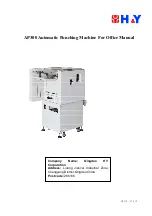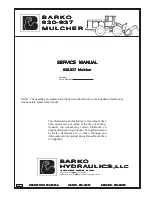
Operation Manual
MELA
quick
®
12
Page 18
7.8
Sliding door cannot be unlocked ___________________________________________
Pressure operated lock of sliding door (1)
As soon as the autoclave has reached a pressure of
0.2 bar, a bolt enters the locking mechanism of the
sliding door and prevents its opening during
process. After the pressure drops to "0", this bolt
releases the locking mechanism so that the sliding
door can be unlocked by a 90° turn counter-
clockwise and be pushed back (marking on knob is
now along with the apparatus' axis), see also
chapter 4.5. If you try to open the door before
pressure is 0 bar, you will not succeed because the
bolt is still locked in. Thus, the sliding door cannot be
completely unlocked and opened.
In this case, lock the door once again (marking is
now crosswise with the apparatus' axis), wait until
pressure drops to "0" and then unlock and open the
door.
If the sliding door still cannot be opened, then it is
jammed by long instruments which protrude too far
upward -- or the mechanical system of the door is
defective. Try to slide the door backward by applying
slightly more force.
If this is not possible you must notify the MELAG
Customer Service Department.
Pressure release takes too long
During normal operations, the pressure indication
has fallen to
„
0“ by the time the lamp
„
END“ (13)
glows and the acoustic signal sounds. If, however,
an extremely great number of unpacked metal
instruments are sterilized together, then re-
evaporation of the resulting condensate can cause a
situation in which the operator must wait a few
seconds after the acoustic signal before the
pressure has completely fallen and the door allows
itself to be opened (as described above).
When the pressure gauge shows a value of 0.2 bar
or more at the end of a cycle (light
„
END“ (13) glows,
with a beep), there is dirt inside the apparatus which
has settled down to the steam filter in front of the
solenoid valve of the pressure release (41).
This filter can be reached from the lower side of the
autoclave without dismantling it (use a spanner with
14 mm).
The filter must be cleaned by a service engineer or
replaced. During this service work, the adjacent
openings should be rinsed and blown out before the
autoclave is reassembled. To perform this, first
remove the filter, then close off the outgoing-water
hose to prevent water from flowing through it. Then
pour demineralized or distilled water into the
pressure chamber and allow it to run through. Then
close the sliding door, and blow through the
outgoing waste water hose.
7.9
The sliding door cannot be easily moved ____________________________________
Normally, the sliding door (1), when unlocked -- see
Section 4.5 -- can be very easily moved: for
example, with 2 fingers. This is because of the
following: the actual metal closure floats over the
door gasket, the door slides on PTFE bearings, and
the door moves into a recess at the rear area of the
autoclave. If the door, however, is difficult to move,
please consider the following possibilities:
Transport damage
If the autoclave has been subjected to violent impact
from the side during transport, it is possible that the
suspension of the upper autoclave plastic cladding
has been bent. In this case, it is possible that the
collar of the cladding of the sliding door (under the
locking handle) collides toward the rear with a
corner of the opening in the upper part of the
autoclave cladding. You must notify the MELAG
Customer Service Department. The technician must
adjust the suspension of the upper autoclave plastic
cladding in order that the collar runs properly in the
centre of the opening.
The metal closure cover does not completely lift
during unlocking.
If the actual metal closure cover (5 mm thick) does
not lift, or completely lift, although the door is fully
unlocked, then the closure will not float over the
gasket and its upper side will not lie flush at the
upper corner of the guide slot. The operator can
then provisionally lift the closure by pressing on the
plastic cladding of the sliding door, and by pulling on
the locking handle, and can then open the
autoclave.
In every case you must notify the MELAG Customer
Service Department.
The problem may be that a technician has forgotten
to reinstall the PTFE bearing pieces between the
closure cladding and the slide rails after a repair job.
Or, the 4 spring-loaded hexagon socket-heat screws
have jammed because of soiling, debris from paint,
or a crooked position in the guides of the closure
cladding. In such case, unscrew the screws, clean
the guides, and screw the screws back in tight by
hand, using the springs and a thread-locking
adhesive.
7.10
Water reservoir goes empty _______________________________________________
If the water gets from the storage tank to the
condenser container and thus gets empty (over
night), there is a leak in the non-return valve of the
pump.
Inform the service engineer who will clean or replace
the pump.
The autoclave can be used in the meantime, if the
cycle successfully runs the end: i.e., if the lamp
„
END“ (13) lights up.







































